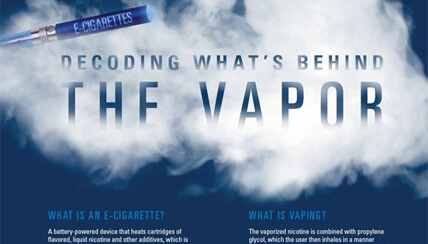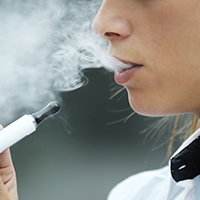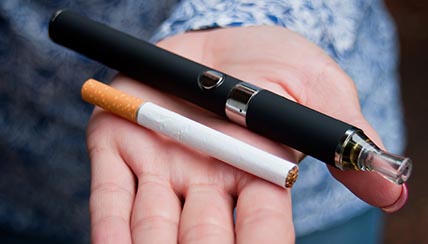E-Cigarettes
 The electronic or e-cigarette is not a safe alternative to smoking.
The electronic or e-cigarette is not a safe alternative to smoking.
Electronic or e-cigarettes are battery-operated devices that generally contain cartridges filled with nicotine, flavor and other chemicals. The electronic cigarette turns nicotine, which is highly addictive, and other chemicals into a vapor that is inhaled by the user.
E-cigarettes are not approved by the Food and Drug Administration (FDA) for safety and effectiveness, and have not been approved to help people quit smoking.
Concerns About Electronic Cigarettes
The FDA has conducted limited laboratory testing on sample products. The results of testing indicated a lack of quality measures as well as inconsistent nicotine levels in products labeled identically. The FDA is attempting to work with electronic cigarette companies to ensure consumer safety at this time.
Quitting Electronic Cigarettes
There are a number of FDA-approved smoking cessation aids that are safe and effective, including nicotine gum, nicotine skin patches, nicotine lozenges, nicotine oral inhaled products, and nicotine nasal spray that are available for smokers to use to reduce their dependence on nicotine.
There have been no efforts to regulate the amount of nicotine in e-cigarettes, some of which contain several times the amount currently found in other tobacco products. E-cigarettes are heavily marketed to adolescents, who are more vulnerable to nicotine addiction than adults.
E-Cigarettes Helping Spark New iSmoke Generation
New York has become the latest big city in the U.S. to ban the use of e-cigarettes in most public places. Chicago and Los Angeles are on board, too. But critics of the ban say e-cigarettes can actually be helpful to those who are trying to quit smoking and are practically harmless to everyone else. But not everyone agrees.
More Information on E-Cigarettes
- What is 'vaping'?
- Different Names for the Same Product
- The Danger to Children
- Nicotine and the Teenage Brain
- E-Cigarette Bans Take Effect In U.S. Cities
- E-Cigarettes Have Taken Us Back 50 Years
- Inhaling Dangerous Chemicals
What is 'vaping'?
 The vaporized nicotine is combined with propylene glycol, which the user then inhales in a manner similar to smoking a cigarette. When the user exhales (vaping), the vapor contains mainly the propylene glycol, which looks like smoke from a cigarette.
The vaporized nicotine is combined with propylene glycol, which the user then inhales in a manner similar to smoking a cigarette. When the user exhales (vaping), the vapor contains mainly the propylene glycol, which looks like smoke from a cigarette.
Different Names for the Same Product
- E-cigarette
- Hookah pen, e-hookah
- Vape pipe, vape pen
 With flavors like green apple, watermelon and blueberry, experts say the manufacturers of e-cigarettes are trying to lure adolescents to use their products. In just one year (2011-2012) the CDC found that use among middle and high school students more than doubled to about two million. From 2013-2014, use of electronic devices tripled among this same age group. Doctors at National Jewish Health in Denver say we don't know enough yet about how e-cigarettes affect the body, and until we do, they are urging the FDA to establish national guidelines to keep them out of the hands of children.
With flavors like green apple, watermelon and blueberry, experts say the manufacturers of e-cigarettes are trying to lure adolescents to use their products. In just one year (2011-2012) the CDC found that use among middle and high school students more than doubled to about two million. From 2013-2014, use of electronic devices tripled among this same age group. Doctors at National Jewish Health in Denver say we don't know enough yet about how e-cigarettes affect the body, and until we do, they are urging the FDA to establish national guidelines to keep them out of the hands of children.
The Danger to Children
- Addictive nicotine content
- Unregulated nicotine levels
- Unregulated mixture of other chemicals
- Packaging
- Advertising
- Targeted marketing
- Flavoring
- Alters brain development
- Renormalizes smoking
Nicotine and the Teenage Brain
 Though many large cities in the U.S. have banned the use of e-cigarettes in most public places, the federal government has been slow to react to their use or efforts by manufacturers to market them to children.
Though many large cities in the U.S. have banned the use of e-cigarettes in most public places, the federal government has been slow to react to their use or efforts by manufacturers to market them to children.
Doctors say inhaling high concentrations of nicotine through e-cigarettes could cause considerable and permanent changes in the brain development of adolescents. Experts at National Jewish Health in Denver are urging the FDA to take a stance on e-cigarettes soon, to keep them out of the hands of children.
E-Cigarette Bans Take Effect In U.S. Cities
“E-cigarettes are easy to find, easy to use and easy to hide for far too many children in this country,” said Amy Lukowski, PsyD, MPH, a psychologist at National Jewish Health in Denver, “and what’s worse is that they are being marketed directly to adolescents.”
Learn more about the dangers of e-cigarettes for children.
E-Cigarettes Have Taken Us Back 50 Years
After so many years fighting legal battles to prevent cigarette manufacturers from targeting children in their advertising for tobacco, guess what—cigarette manufacturers are using the same and more powerful tactics to entice children and adults to use e-cigarettes.
Read more about the growing popularity of e-cigarettes (PDF).
Inhaling Dangerous Chemicals
E-cigarette liquids are typically solutions of propylene glycol, glycerol or both, plus nicotine and flavorant chemicals. The liquid in e-cigarettes does not contain the tar, smoke or carbon monoxide that traditional cigarettes do, but it does include chemicals that are dangerous to the brain, heart and lung health including:
Acetaldehyde
Acetaldehyde is in cannabis and e-cigarette smoke. It irritates the skin, eyes, mucous membranes, throat and respiratory tract. It can also cause nausea, vomiting, headache, drowsiness, delirium and hallucinations in high concentrations. Other effects of acetaldehyde can include damage the mucous lining of the mouth, throat, stomach; skin irritation; kidney and liver damage; and cancer. Acetaldehyde is also known as acetic aldehyde, ethanal, ethyl aldehyde.
Diacetyl
This chemical is used to add flavorings to electronic cigarettes, some microwave popcorns and other foods and liquids. Inhaling diacetyl, especially the heated chemical, has been linked to serious respiratory diseases including bronchiolitis obliterans which is irreversible. When inhaled, diacetyl can cause a persistent dry cough, shortness of breath, wheezing, phlegm production, fatigue, drowsiness, headache, fever, aches and nausea. However, exposed workers have developed lung disease in the absence of these warning symptoms. Diacetyl vapors irritate the eyes, skin, nose and throat and may lead to fixed airway restriction or obstruction. Diacetyl is also known as butanedione, 2,3-butandedione and food flavorings containing diacetyl (FFCD).
Formaldehyde
This colorless, flammable gas is used in building materials, household products, pressed-wood products, glues and adhesives, some fabrics, insulation materials, paper coatings, fungicides, germicides, disinfectants, and medical and scientific preservatives. Formaldehyde is a carcinogen. It has a strong odor and can irritate the eyes, nose, skin and throat, and causes coughing, wheezing and nausea. Formaldehyde is also known as methanal.
Nicotine
This chemical compound is a stimulant drug that is found in the nightshade family of plants including nicotiana rustica (Opens in a new window) (Opens in a new window), cultivated tobacco (Opens in a new window) (Opens in a new window) and asclepias syriaca (Opens in a new window) (Opens in a new window).
Nicotine is highly addictive and is associated with cardiovascular disease, birth defects, lung infections. Inhaling nicotine stimulates production of saliva and phlegm, increases heart rate and blood pressure, elevates serum cholesterol levels, promotes blood clot formation, and aids in plaque formation in the cardiovascular system.
This content was reviewed by Cecile S. Rose, MD, MPH, February 2016.
